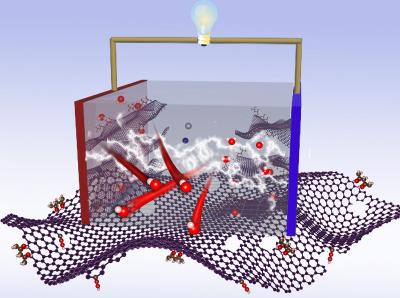Novel approach improves graphene-based supercapacitors

An efficient pathway to improve performance of supercapacitors Credit: Dawei Su
Demand for integrated energy storage devices is growing rapidly as people rely more and more on portable and wireless electronics, and the global need grows for clean energy sources such as solar and wind energies.
This is creating an exponential need for advanced energy storage technologies – reliable and maintenance-free batteries and supercapacitors (SC) with high power density capability as storage devices. Supercapacitors are prominent candidates to meet this need due to their environmentally friendly and long cyclability characteristics.
Researchers from the Integrated Nano Systems Lab (INSys Lab), in the Centre for Clean Energy Technology, have been working on a pathway to improve the performance of supercapacitors, and meet that demand for increased storage capacity.
Dr Mojtaba Amjadipour and Professor Francesca Iacopi (School of Data and Electrical Engineering) and Dr Dawei Su (School of Mathematical and Physical Sciences) describe their cutting-edge work in the July 2020 issue of the journal Batteries and Supercaps.
The prominence given to Graphitic-Based Solid-State Supercapacitors: Enabling Redox Reaction by In Situ Electrochemical Treatment – designated a Very Important Paper with front coverage placement – signifies just how innovative their research is in developing alternate ways to extend storage capacity.
Dr Iacopi said the multi-disciplinary approach within the team was beneficial in discovering what she says is a simple process.
“This research has originated from our curiosity of exploring the operation limits of the cells, leading us to unforeseen beneficial results. The control of this process would not have been possible without understanding the fundamental reasons for the observed improvement, using our team's complementary expertise.”
Traditionally, supercapacitors are fabricated with liquid electrolytes, which cannot be miniaturised and can be prone to leakage, prompting research into gel-based and solid-state electrolytes. Tailoring these electrolytes in combination with carbon-based electrode materials such as graphene, graphene oxide, and carbon nanotubes is of paramount importance for an enhanced energy storage performance.
Graphene or graphitic carbon directly fabricated on silicon surfaces offers significant potential for on-chip supercapacitors that can be embedded into integrated systems. The research insights indicate a simple path to significantly enhance the performance of supercapacitors using gel-based electrolytes, which are key to the fabrication of quasi-solid-(gel) supercapacitors.
“This approach offers a new path to develop further miniaturized on-chip energy storage systems, which are compatible with silicon electronics and can support the power demand to operate integrated smart systems,” Dr Iacopi said.
Media Contact
All latest news from the category: Information Technology
Here you can find a summary of innovations in the fields of information and data processing and up-to-date developments on IT equipment and hardware.
This area covers topics such as IT services, IT architectures, IT management and telecommunications.
Newest articles

NASA: Mystery of life’s handedness deepens
The mystery of why life uses molecules with specific orientations has deepened with a NASA-funded discovery that RNA — a key molecule thought to have potentially held the instructions for…

What are the effects of historic lithium mining on water quality?
Study reveals low levels of common contaminants but high levels of other elements in waters associated with an abandoned lithium mine. Lithium ore and mining waste from a historic lithium…

Quantum-inspired design boosts efficiency of heat-to-electricity conversion
Rice engineers take unconventional route to improving thermophotovoltaic systems. Researchers at Rice University have found a new way to improve a key element of thermophotovoltaic (TPV) systems, which convert heat…



